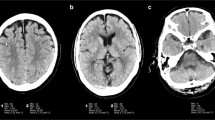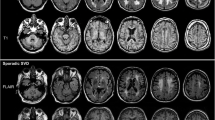Abstract
Introduction
The aim if this study is to find out if contrast between gray (GM) and white matter (WM) on non-enhanced brain CT (NECT) can be enhanced by using a frequency selective non-linear blending.
Methods
Thirty consecutive patients (40 % female; mean age 67.73 ± 12.71 years), who underwent NECT of the brain, were retrospectively included in this study. Brain scan readings were performed by two radiologists independently, for NECT and subsequently the images were read using a new frequency selective non-linear blending algorithm (best contrast, BC). Optimal settings of BC for enhanced delineation of anatomical structures were set at an averaged center of 30 HU, averaged delta of 5 HU, and a slope of 5. For contrast-to-noise ratio calculation (CNR), gray and white matter attenuation values were measured for both NECT and BC in different anatomical structures.
Results
CNR increase in the gray matter was 5.91 ± 2.45 for the cortical gray matter and 4.41 ± 1.82 for the basal ganglia. The contrast ratio between cortical gray and white matter was 1.87 and 1.7 (basal ganglia/WM) for BC quantification vs. 1.43 (cortex/WM) and 1.33 (basal ganglia/WM) for standard NECT (both p < 0.0001). Improved CNR did not depend on the anatomical structures measured.
Conclusion
Frequency selective non-linear blending allows better discrimination between WM and GM and therefore may enhance diagnostic accuracy of NECT.




Similar content being viewed by others
References
Diaconis JN, Rao KC (1980) CT in head trauma: a review. J Comput Tomogr 4:261–270
Kloska SP, Nabavi DG, Gaus C, Nam EM, Klotz E, Ringelstein EB, Heindel W (2004) Acute stroke assessment with CT: do we need multimodal evaluation? Radiology 233:79–86
Kim DS, Na DG, Kim KH, Kim JH, Kim E, Yun BL, Chang KH (2009) Distinguishing tumefactive demyelinating lesions from gloom or central nervous system lymphoma: added value of unenhanced CT compared with conventional contrast-enhanced MR imaging. Radiology 251:467–475
Dumas MD, Pexman JH, Kreeft JH (1994) Computed tomography evaluation of patients with chronic headache. CMAJ 151:1447–1452
Jacoby JH, DiMarcangelo MT, Kramer ED (1993) Imaging of herpes simplex encephalitis. N J Med 90:612–614
Craddock C, Chen MY, Dixon RL, Schlarb CA, Williams DW 3rd (2006) The effect of skull volume and density on differentiating gray and white matter on routine computed tomography scans of the head. J Comput Assist Tomogr 30:734–738
Love A, Siemund R, Hoglund P, Van Westen D, Stenberg L, Petersen C, Bjorkman-Burtscher IM (2014) Hybrid iterative reconstruction algorithm in brain CT: a radiation dose reduction and image quality assessment study. Acta Radiol 55:208–217
Korn A, Fenchel M, Bender B, Danz S, Hauser TK, Ketelsen D, Flohr T, Claussen CD, Heuschmid M, Ernemann U, Brodoefel H (2012) Iterative reconstruction in head CT: image quality of routine and low-dose protocols in comparison with standard filtered back-projection. AJNR 33:218–224
Pexman JH, Barber PA, Hill MD, Sevick RJ, Demchuk AM, Hudon ME, Hu WY, Buchan AM (2001) Use of the Alberta Stroke Program Early CT Score (ASPECTS) for assessing CT scans in patients with acute stroke. AJNR 22:1534–1542
Bongers MN, Schabel C, Krauss B, Tsiflikas I, Ketelsen D, Mangold S, Claussen CD, Nikolaou K, Thomas C (2015) Noise-optimized virtual monoenergetic images and iodine maps for the detection of venous thrombosis in second-generation dual-energy CT (DECT): an ex vivo phantom study. Euro Radiol 25:1655–1664
Weinstein MA, Duchesneau PM, MacIntyre WJ (1977) White and gray matter of the brain differentiated by computed tomography. Radiology 122:699–702
Bodelle B, Wichmann JL, Scholtz JE, Lehnert T, Vogl TJ, Luboldt W, Schulz B (2015) Iterative reconstruction leads to increased subjective and objective image quality in cranial CT in patients with stroke. AJR 205:618–622
Nishizawa M, Tanaka H, Watanabe Y, Kunitomi Y, Tsukabe A, Tomiyama N (2015) Model-based iterative reconstruction for detection of subtle hypoattenuation in early cerebral infarction: a phantom study. Jpn J Radiol 33:26–32
Zhang Y, Brady M, Smith S (2001) Segmentation of brain MR images through a hidden Markov random field model and the expectation-maximization algorithm. IEEE Trans Med Imaging 20:45–57
Knecht S, Wersching H, Lohmann H, Bruchmann M, Duning T, Dziewas R, Berger K, Ringelstein EB (2008) High-normal blood pressure is associated with poor cognitive performance. Hypertension 51:663–668
Klein A, Andersson J, Ardekani BA, Ashburner J, Avants B, Chiang MC, Christensen GE, Collins DL, Gee J, Hellier P, Song JH, Jenkinson M, Lepage C, Rueckert D, Thompson P, Vercauteren T, Woods RP, Mann JJ, Parsey RV (2009) Evaluation of 14 nonlinear deformation algorithms applied to human brain MRI registration. NeuroImage 46:786–802
Maldjian JA, Chalela J, Kasner SE, Liebeskind D, Detre JA (2001) Automated CT segmentation and analysis for acute middle cerebral artery stroke. AJNR 22:1050–1055
Tijssen MP, Hofman PA, Stadler AA, van Zwam W, de Graaf R, van Oostenbrugge RJ, Klotz E, Wildberger JE, Postma AA (2014) The role of dual energy CT in differentiating between brain haemorrhage and contrast medium after mechanical revascularisation in acute ischaemic stroke. Eur Radiol 24:834–840
Pomerantz SR, Kamalian S, Zhang D, Gupta R, Rapalino O, Sahani DV, Lev MH (2013) Virtual monochromatic reconstruction of dual-energy unenhanced head CT at 65–75 keV maximizes image quality compared with conventional polychromatic CT. Radiology 266:318–325
Scholtz JE, Husers K, Kaup M, Albrecht M, Schulz B, Frellesen C, Bodelle B, Wagenblast J, Kerl JM, Bauer RW, Lehnert T, Vogl TJ, Wichmann JL (2015) Non-linear image blending improves visualization of head and neck primary squamous cell carcinoma compared to linear blending in dual-energy CT. Clin Radiol 70:168–175
Gacs G, Fox AJ, Barnett HJ, Vinuela F (1983) CT visualization of intracranial arterial thromboembolism. Stroke 14:756–762
Post MJ, Tate LG, Quencer RM, Hensley GT, Berger JR, Sheremata WA, Maul G (1988) CT, MR, and pathology in HIV encephalitis and meningitis. AJR 151:373–380
Mileto A, Ramirez-Giraldo JC, Marin D, Alfaro-Cordoba M, Eusemann CD, Scribano E, Blandino A, Mazziotti S, Ascenti G (2014) Nonlinear image blending for dual-energy MDCT of the abdomen: can image quality be preserved if the contrast medium dose is reduced? AJR 203:838–845
Ippolito D, Talei Franzesi C, Fior D, Bonaffini PA, Minutolo O, Sironi S (2015) Low kV settings CT angiography (CTA) with low dose contrast medium volume protocol in the assessment of thoracic and abdominal aorta disease: a feasibility study. Br J Radiol 88(1049):20140140
Laqmani A, Regier M, Veldhoen S, Backhaus A, Wassenberg F, Sehner S, Groth M, Nagel HD, Adam G, Henes FO (2014) Improved image quality and low radiation dose with hybrid iterative reconstruction with 80 kV CT pulmonary angiography. Eur J Radiol 83:1962–1969
Tang K, Li R, Lin J, Zheng X, Wang L, Yin W (2015) The value of cerebral CT angiography with low tube voltage in detection of intracranial aneurysms. BioMed Res Int 2015:876796
Lehr JL, Capek P (1985) Histogram equalization of CT images. Radiology 154:163–169
Fayad LM, ** Y, Laine AF, Berkmen YM, Pearson GD, Freedman B, Van Heertum R (2002) Chest CT window settings with multiscale adaptive histogram equalization: pilot study. Radiology 223:845–852
Gomori JM, Steiner I (1987) Non-linear CT windows. Comput Radiol 11:21–27
Author information
Authors and Affiliations
Corresponding author
Ethics declarations
We declare that all human studies have been approved by the ethics committee of the Eberhard Karls University Tübingen and have therefore been performed in accordance with the ethical standards laid down in the 1964 Declaration of Helsinki and its later amendments. We declare that due to the retrospective nature of this study, informed consent was waived.
Conflict of interest
HD is an employee of Siemens AG.
Rights and permissions
About this article
Cite this article
Bier, G., Bongers, M.N., Ditt, H. et al. Enhanced gray-white matter differentiation on non-enhanced CT using a frequency selective non-linear blending. Neuroradiology 58, 649–655 (2016). https://doi.org/10.1007/s00234-016-1674-1
Received:
Accepted:
Published:
Issue Date:
DOI: https://doi.org/10.1007/s00234-016-1674-1




